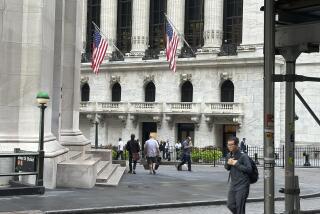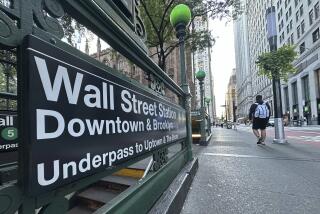Anxiety eases, but questions persist
- Share via
The curtain dropped on the third quarter Friday, and the surprise to many stock investors might be that their portfolios came through the summer not much worse for the wear and tear.
Despite a harrowing global credit crunch, a continuing downward spiral in housing and record highs for oil prices, the blue-chip-dominated Standard & Poor’s 500 stock index rose 1.6% in the three months.
That lifted its year-to-date gain to 7.6% -- besting the 7% advance for the same period last year.
The average U.S. stock mutual fund was up about 1% in the quarter and is up nearly 10% for the year, according to preliminary data from fund tracker Lipper Inc.
For all of the summer turmoil in markets and the financial system, “equities seem to be untouched,” said Doug Peta, strategist at money manager J&W; Seligman & Co. in New York.
Indeed, the Dow Jones industrial average, which eased 17.31 points, or 0.1%, to 13,895.63 on Friday, is back within 0.8% of its all-time high of 14,000.41 reached July 19.
The picture was much different in mid-August, of course. Fear of a meltdown in the financial system stemming from the housing market’s woes helped spark the deepest pullback in stocks in more than four years. The S&P; 500 slumped 9.4% from July 20 to Aug. 15.
But the Federal Reserve rode to the rescue Aug. 17 with a cut in its bank lending rate. It followed that on Sept. 18 with a half-point drop in its most important rate, the federal funds rate, to 4.75%.
And as usual, rate cuts worked like Xanax on the stock market: Anxiety melted away.
Now what?
Here are some key questions Wall Street will face as the final quarter of the year gets underway Monday:
Will recession worries fade or resurge?
For stock investors, it always comes down to the economy. The summer credit crunch was a problem for many companies only insofar as it raised the risk of a sharp slowdown in economic growth or actual contraction (i.e., recession). If growth fades, so may earnings, which are what underpin share prices.
The stock market’s verdict so far is that recession isn’t likely. But some economists aren’t so sure.
Susan Sterne, head of Economic Analysis Associates Inc. in Greenwich, Conn., sees a 50% chance of recession on the horizon.
She thinks that the sinking housing market and tighter credit are bound to rattle many corporate executives, making them more cautious about their own companies’ spending -- which could intensify the threat to the economy overall.
But consumers rule in the U.S. economy, and they’re still spending at a decent pace. The government said Friday that personal consumption rose 0.6% in August, the biggest increase in four months.
Third-quarter corporate earnings reports, which will begin to roll out in mid-October, may provide some of the best intelligence on the economy’s trend. Wall Street analysts aren’t expecting much: a mere 3.9% year-over-year rise in operating profit for the S&P; 500 companies, which would be the slowest growth in five years, according to Thomson Financial.
If companies pull off the usual upside surprises, the stock market’s mood may get another boost. But if earnings fall short of already low expectations, the inherent message about the economy may be grim.
Can the bull market’s leaders keep saving the day?
The U.S. stock market this year is a place of haves and have-nots. The haves are the industrial, commodity and technology sectors, which are riding the global economic boom. The have-nots are anything related to the housing sector as well as some sectors dependent on consumer spending.
Cases in point: Shares of industrial conglomerate United Technologies Corp. hit a record high this week and are up 28.7% year to date. By contrast, retailer Home Depot Inc. is down 19.2%.
The gains in industrial, commodity and technology issues are pumping up broad market indexes. Those sectors will have to keep rolling if the bull is to carry on, assuming the have-nots don’t begin to snap back any time soon.
Mary Ann Bartels, chief market analyst at Merrill Lynch & Co. in New York, remains a believer in the industrial and commodity sectors in particular, she said. They are benefiting from what she expects to be a long-lasting trend of infrastructure buildup around the world -- not just in China and India, but also in Latin America, Eastern Europe and even in the U.S.
The last such global buildup, Bartels said, was from 1942 to 1968. That’s why some on Wall Street have trouble appreciating the potential in infrastructure-related stocks, Bartels said.
“Many investors have never lived through a cycle when industrial stocks led the market,” she said.
Will the sinking dollar become more of a liability than an asset?
The Fed sacrificed the greenback’s value when it started cutting interest rates. Since Aug. 17, the euro has rocketed from $1.35 to Friday’s record high of nearly $1.43, and the dollar has been in a slow-motion meltdown against many other currencies.
For the moment, many U.S. investors are reveling in the weak dollar. Not only is it boosting U.S. exporters’ prospects (by making their goods less expensive abroad), but strong foreign currencies lift the value of foreign stocks and bonds in Americans’ portfolios.
The average European blue-chip stock fell 3.9% in the third quarter in euros -- but was up 0.5% in dollars. The year-to-date gain for the average foreign stock fund is a hefty 17.2%, according to Morningstar Inc.
But as the dollar keeps sliding, risks grow that foreign investors will tire of seeing their U.S. assets devalued. If they begin to dump U.S. securities, the Fed could be forced to halt its rate-cutting campaign to try to support the buck’s value.
The sinking dollar also fans inflation worries by driving up import prices.
And that’s the potential problem for some foreign companies and their stocks: If their strong currencies make them un-competitive in the global marketplace and their earnings begin to slide, the shares could get hammered.
“The big risk of recession isn’t in the U.S. -- it’s in continental Europe,” said Milton Ezrati, economic strategist at Lord Abbett & Co. in Jersey City, N.J.
“Exports are a much bigger part of that economy” than is true of the U.S., he said.
Some European politicians have begun to plead for the U.S. to take steps to stop the dollar’s dive.
The risk that foreign markets could get slammed because of the dollar’s slump is one reason Kurt Brouwer, a principal at investment advisory firm Brouwer & Janachowski Inc. in Tiburon, Calif., is wary of increasing his clients’ stake in foreign stocks in the near term, he said.
“You have to ask about foreign investing: Could it get any better than it has been in the last few years?” Brouwer said.
More to Read
Inside the business of entertainment
The Wide Shot brings you news, analysis and insights on everything from streaming wars to production — and what it all means for the future.
You may occasionally receive promotional content from the Los Angeles Times.










